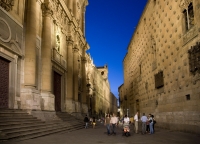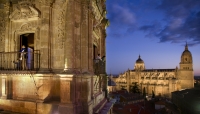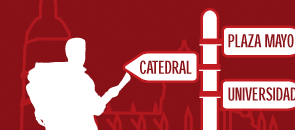Routes
When visiting Salamanca, you must come in the mood for enjoying and allowing yourself to be surprised by a cosmopolitan, kind, and safe university town.
We invite you to discover it. Thanks to its humanist tradition and rich historic heritage, the city was declared World Heritage Site by UNESCO, and European Capital of Culture.
Salamanca is considered the quintessential Spanish Renaissance city, which makes it unique, both in terms of the architectural and urban aesthetic of the city, that is still visible, as well as due to the humanist thinking and yearning for knowledge—typical of the period—that shaped the city.
Everything in the city center is within walking distance, and there is a stunning variety of palaces, convents, churches, and squares of different styles.
The year 1254 was a key date in the city, that gave it a universal relevance—Alfonso X of Castile founded its university, the first one in Spain and one of the four oldest in the world, together with the universities of Paris, Oxford, and Bologna. Since then, the city grew to become the ideal space for the cultivation of mind and spirit, a tolerant and open melting pot.
Currently, Salamanca has 150,000 inhabitants, a figure that is completed every year with the students that arrive to the city—universities receive around 30,000 students, and Spanish learning centers some 34,000 foreign visitors.
www.salamanca.es
HIGHLIGHTS
Plaza Mayor
It is one of the most beautiful squares in Spain and in the world, and one of the seminal examples of Baroque architecture in the Iberian Peninsula. The square features 88 arches and numerous carved medallions.
The city's most relevant religious, civil, and leisure activities took place here—bullfights, processions, and even executions.
Cathedrals
Another excellent historic and artistic ensemble, as the old and new cathedrals stand side by side. The New Cathedral is Gothic, Renaissance, and Baroque, while the old one, built in Romanesque style, is an architecturally defensive building connected to the repopulation process.
The Ieronimus tour of the cathedral towers is one of the not-to-be-missed experiences in the Salamanca. It includes visiting the cathedral's medieval towers, climbing up the bell tower, and enjoying an amazing view of the city and the river banks from the terraces.
University of Salamanca
One of the most relevant buildings in Salamanca, and a gem within Spanish Renaissance art. This university headquarters was founded in 1218 and soon became a reference, together with the universities of Oxford, Bologna, and Paris. The building's jewel is its Plateresque facade. The Fray Luis de León classroom, its Historic Library, and the Cielo de Salamanca (Salamanca Sky), as well as the courtyards, are also outstanding.
San Esteban Convent
Grandiose 16th century renaissance building that hosts prominent Baroque works like its altarpiece and wall paintings. This spectacular monument includes a large temple, beautiful cloisters, and numerous spaces where Dominican monks still live nowadays. Illustrious students and teachers inhabited its classrooms. This is the place where the “School of Salamanca” was founded, and International Law initiated.
Casa de las Conchas (House of the Shells)
One of Salamanca's most renowned palaces, and one of the best examples of Spanish Gothic civil architecture. It was commissioned during the last years of the 15th century and the first of the 16th by Mr. Rodrigo Arias Maldonado, loyal to the Catholic Kings and a knight of the Order of Santiago. Shells are the main decoration in the facade.
Real Clerecía de San Marcos (Royal Clergy of Saint Mark)
The Royal School of the Jesuit order was built, among others, by Gómez de Mora in 1611. It took 150 years to complete it, and when the Jesuits were expelled from Spain in 1767 by Charles III, the building was divided into several parts, subsequently suffering from neglect, wars, the Spanish Confiscation, and dereliction. In 1946 it was reinstated, and the Universidad Pontificia (Pontifical University) was founded in it. The tour of the Clerecía towers, Scala Coeli, is an attractive activity offered here.
Origins of the City: Pozo de Nieve (Snow Well), Cerro de San Vicente (San Vicente Hill), and Old Wall.
These sites help to better understand the traces left by those who inhabited the city, as shown through the different excavations led by archaeologists. The Cerro de San Vicente allows visitors to get acquainted with the habits of the first farmers in Iron Age I. The Pozo de Nieve is an impressive well, over 7 meters deep, where snow from the mountains was stored in the past. The Interpretation Center (Centro de Interpretación) of the Salamanca walls is the place to learn about the history of Salamanca and the evolution of the city.
Galería Urbana (Urban Gallery) Barrio del Oeste
A very special neighborhood, the most artistic and cultural one, where garage doors, storefront rolling shutters, walls, and street furniture turn into canvases. An Urban Gallery open 24 hours, 365 days a year. The project is based on the works by young artists from different areas of the world who are spreading different aesthetic practices within contemporary art, filling this neighborhood with life and color.
Art Nouveau and Art Déco Museum. Casa Lis
Some of the city's most precious treasures are nested inside this mansion, known by its stained-glass gallery. 19 decorative arts collections from the 19th and beginning of the 20th century, that include close to 2500 excellent quality, perfectly preserved pieces donated by the antiques dealer Mr. Manuel Ramos Andrade.
It is currently hosting the exhibit Picasso, Miró, Dalí. The Great 20th Century Spanish Masters. Graphic Work.
Museo de Historia de la Automoción (Salamanca Motor Museum)
The former “Electric Factory” (Fábrica de la Luz) was turned into one of Europe’s most relevant museums. A pilgrimage destination for motor enthusiasts, with hundreds of pieces that tell a story—automobiles, motorbikes, thousands of pieces, accessories, and objects related to the history of automobiles. It shows the evolution of car design up to our days, and into the future.
Palacio de Monterrey (Monterrey Palace)
A full museum tour of a palace that was listed as National Monument in 1929, and whose architectural style is considered a model for the Spanish Plateresque, among other reasons due to its magnificent crestings. Some highlights exhibited in the interiors include pieces from the Fundación Casa de Alba collection, like the two landscapes by Francisco de Ribera, oil paintings by Sánchez Coello, Carreño de Miranda, Salvatore Rosa, and Titian, among others, as well as its rich ensemble of decorative arts. Tours cover over a dozen of the Palace’s private halls and rooms.
Experiencing Salamanca from its highest viewpoints is a unique experience; it is inhaling inspiration, awakening, opening one’s eyes, understanding the city, and touching its sky.
Salamanca’s towers have opened their doors so that we may gaze from their battlements, admire their pinnacles, and touch their bells.
From the Ieronimous Cathedral towers, the Clerecía towers, known as Scala Coeli [Stairway to Heaven], and the San Esteban Convent’s viewpoint, we may contemplate Salamanca’s grandeur. A city where a great variety of architectural styles intermingle in splendid harmony. A city, whose impressive scenery, recognised World Heritage Site, was conceived as a place of convergence.
Ieronimus
The towers of Salamanca Cathedral
A tour of its interior allows us to discover the history of its construction, to delve into its 900 years of art and history through a documenting exhibition and to access some of its marvels; the Old Cathedral and its main altar; the Mocha Tower terrace, from where one can look upon the Tormes river; the Gallo Tower, the view of the New Cathedral from the clerestory; the Anaya terrace, with its views of the north and west of the city, and, at its highest point, the belfry, which affords a panoramic, 360-degree views.
An unprecedented view, both for residents and tourists alike.
Daytime and night-time tours.
Plaza Juan XXIII s/n.
Tel. 923 266 701
www.ieronimus.es
Scala Coeli
The Clerecía towers
Scala Coeli is a unique “Stairway to heaven” that allows the visitor to discover the history of the Colegio Real de la Compañía de Jesús (Royal College of the Society of Jesus). The construction of the building, which today houses the Universidad Pontificia (Catholic Pontifical University), was initiated in 1617 by order of Queen Margaret of Austria and Philip III as the main centre of education for the Jesuits, who would later be sent to the American colonies and central European Protestant countries. It is, at present, a splendid example of the Baroque period.
The tour includes access to the galleries, from whose balconies one can look upon the interior of the Real Clerecía de San Marcos. The tour continues up the stairway which accesses the church’s two towers. The climb up the Escalera del Campanero [Bell Ringer’s Staircase] is an experience of light and sounds. Due to its height, the passage between both towers affords unique views of Salamanca, providing one with spectacular perspectives of the historic quarters of this city of heritage.
Year-round daytime tours. Night-time tours also available in the summer.
C/ Compañía, 5.
Tel. 923 277 174
www.torresdelaclerecia.com
San Esteban Convent
Roof-top terrace above the facade.
A viewpoint of the heavens.
A new balcony within the monumental and historic San Esteban Convent. A window onto history and art.
The tour provides access to different quarters of the convent, such as the cloisters, the choir stalls, the church and the new areas converted into museum, as well as the ascent to the rooftop terrace situated over the convent facade, one of the most beautiful examples of the Plateresque movement. From here, one can see the south-east of the city, the cathedrals, the Clerecía building and the historic quarters.
Day-time tours.
Plaza del Concilio de Trento s/n.
Tel. 923 215 000
www.conventosanesteban.es













